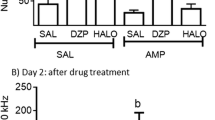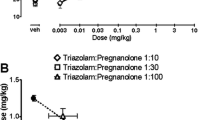Abstract
The effects of benzodiazepine (BZ) antagonists on operant behavior were examined in rats chronically administered a low dose of diazepam (DZ). The low maintenance dose of DZ (5 mg/kg twice daily) was selected as more closely associated with its anxiolytic effects than the higher treatment doses previously used to study BZ dependence. Food-restricted rats were trained to press a lever for food reinforcement under a FR20 schedule of reinforcement prior to the start of DZ administration. Acute administration of DZ caused a dose-dependent reduction of response rates, with 5 mg/kg causing a 50% decrease. Rats treated chronically with DZ became tolerant to its rate-suppressant effects as shown by a 5-fold increase in the dose of DZ required to reduce FR20 response rates by 50%. The BZ antagonist flumazenil (formerly Ro 15-1788; 10–56 mg/kg) suppressed rates of responding in rats treated chronically with DZ. The suppression of operant responding was obtained when flumazenil was given up to 3 h, but not 18 h, after the last treatment with DZ. In contrast, only the highest dose of flumazenil (56 mg/kg) caused reductions of operant responding when given to rats treated with saline. The BZ antagonist CGS 8216 (3.3–33 mg/kg IP), given 10 min prior to the session, was similarly more potent and effective at suppressing operant responding in rats treated chronically with DZ than saline. This procedure may provide a model for the clinical problem of physical dependence to chronically-administered low, anxiolytic doses of BZ tranquilizers.
Similar content being viewed by others
References
Balster RL (1985) Behavioral studies of tolerance and dependence. In: Seiden LS, Balster RL (eds) Behavioral pharmacology: the current status. Liss, New York, pp 403–418
Boast CA, Bernard PS, Barbaz BS, Bergen KM (1983) The neuropharmacology of various diazepam antagonists. Neuropharmacology 22:1511–1521
Bonetti EP, Pieri L, Cumin R, Schaffner R, Pieri M, Gamzu ER, Muller RKM, Haefely W (1982) Benzodiazepine antagonist Ro 15-1788: neurological and behavioral effects. Psychopharmacology 78:8–18
Emmett-Oglesby MW, Spencer Jr. DG, Elmesallamy F, Lal H (1983) The pentylenetetrazol model of anxiety detects withdrawal from diazepam in rats. Life Sci 33:161–168
Emmett-Oglesby MW, Mathis DA, Harris CM, Idemudia SO, Lal H (1988) Withdrawal from diazepam substitutes for the discriminative stimulus properties of pentylenetetrazol. J Pharmacol Exp Ther 244:892–897
Friedman H, Abernethy DR, Greenblatt DJ, Shader RI (1986) The pharmacokinetics of diazepam and desmethyldiazepam in rat brain and plasma. Psychopharmacology 88:267–270
Gallaher EJ, Henauer SA, Jacques CJ, Hollister LE (1986) Benzodiazepine dependence in mice following ingestion of drug-containing food pellets. J Pharmacol Exp Ther 237:462–467
Gonsalves SF, Gallager DW (1988) Persistent reversal tolerance to anticonvulsant effects and GABAergic subsensitivity by a single exposure to benzodiazepine antagonist during chronic benzodiazepine administration. J Pharmacol Exp Ther 244:79–83
Lamb RJ, Griffiths RR (1985) Effects of repeated Ro 15-1788 administration in benzodiazepine-dependent baboons. Eur J Pharmacol 110:257–261
Lister RG, Greenblatt DJ, Abernethy DR, File SE (1984) Pharmacokinetic studies on Ro 15-1788, a benzodiazepine receptor ligand, in the brain of the rat. Brain Res 290:183–186
Little HJ, Nutt DJ, Taylor SC (1987) Bidirectional effects of chronic treatment with agonists and inverse agonists and the benzodiazepine receptor. Brain Res Bull 19:371–378
Lucki I, Rickels K, Geller AM (1986) Chronic use of benzodiazepines and psychomotor and cognitive test performance. Psychopharmacology 88:426–433
Lukas SE, Griffiths RR (1982) Precipitated withdrawal by a benzodiazepine receptor antagonist (Ro 15-1788 after 7 days of diazepam. Science 217:1161–1163
Lukas SE, Griffiths RR (1984) Precipitated diazepam withdrawal in baboons: effects of dose and duration of diazepam exposure. Eur J Pharmacol 100:163–171
Martin WR, McNicholas LF, Cherian S (1982) Diazepam and pentobarbital dependence in the rat. Life Sci 31:721–730
McNicholas LF, Martin WR (1982) The effect of a benzodiazepine antagonist, Ro15-1788, in diazepam dependent rats. Life Sci 31:731–737
Petersen EN, Jensen LH (1987) Chronic treatment with lorazepam and FG 7142 may change the effects of benzodiazepine receptor agonists, antagonists and inverse agonists by different mechanisms. Eur J Pharmacol 133:309–317
Rickels K, Case WG, Downing RW, Winokur A (1983) Long-term diazepam therapy and clinical outcome. JAMA 250:767–771
Rickels K, Case WG, Schweizer EE, Swenson C, Fridman RB (1986) Low-dose dependence in chronic benzodiazepine users: a preliminary report on 119 patients. Psychopharmacol Bull 22:407–415
Rickels K, Schweizer EE, Csanalosi I, Case WG, Chung N (1988) Long-term treatment of anxiety and risk of withdrawal: prospective comparison of clorazepate and buspirone. Arch Gen Psychiatry 45:444–450
Rosenberg HC, Chiu TH (1985) Time course for development of benzodiazepine tolerance and physical dependence. Neurosci Biobehav Rev 9:123–131
Roy-Byrne PP, Hommer D (1988) Benzodiazepine withdrawal: overview and implications for the treatment of anxiety. Am J Med 84:1041–1052
Ryan GP, Boisse NR (1983) Experimental induction of benzodiazepine tolerance and physical dependence. J Pharmacol Exp Ther 226:100–107
Sanger DJ (1986) Investigation of the actions of the benzodiazepine antagonists Ro 15-1788 and CGS 8216 using the schedule-controlled behavior of rats. Pharmacol Biochem Behav 25:537–541
Schopf J (1983) Withdrawal phenomena after long-term administration of benzodiazepines: a review of recent investigations. Pharmacopsychiatria 16:1–8
Shannon HE, Katzman NJ (1986) CGS 8216: Agonist and diazepam-antagonist effects in rodents. J Pharmacol Exp Ther 239:166–173
Spealman RD (1986) Disruption of schedule-controlled behavior by Ro 15-1788 one day after acute treatment with benzodiazepines. Psychopharmacology 88:398–400
Takada K, Suzuki T, Hagen T, Cook JM, Katz JL (1989) Behavioral effects of benzodiazepine antagonists in chlordiazepoxide tolerant and non-tolerant rats. Life Sci 44:289–299
Thiebot M-H, Soubrie P, Sanger D (1988) Anxiogenic properties of beta-CCE and FG 7142: a review of promises and pitfalls. Psychopharmacology 94:452–463
Valentino RJ, Herling S, Woods JH (1983) Discriminative stimulus effects of naltrexone in narcotic-naive and morphine-treated pigeons. J Pharmacol Exp Ther 224:307–313
Woods JH, Katz JL, Winger G (1987) Abuse liability of benzodiazepines. Pharmacol Rev 39:251–413
Yanagita T (1985) Dependence potential of the benzodiazepines: use of animal models for assessment. Clin Neuropharmacol [Suppl 1]8:S118-S122
Young R, Urbancic A, Emrey T, Hall PC, Metcalf G (1987) Behavioral effects of several new anxiolytics and putative anxiolytics. Eur J Pharmacol 143:361–371
Author information
Authors and Affiliations
Rights and permissions
About this article
Cite this article
Lucki, I., Kucharik, R.F. Increased sensitivity to benzodiazepine antagonists in rats following chronic treatment with a low dose of diazepam. Psychopharmacology 102, 350–356 (1990). https://doi.org/10.1007/BF02244103
Received:
Revised:
Issue Date:
DOI: https://doi.org/10.1007/BF02244103




